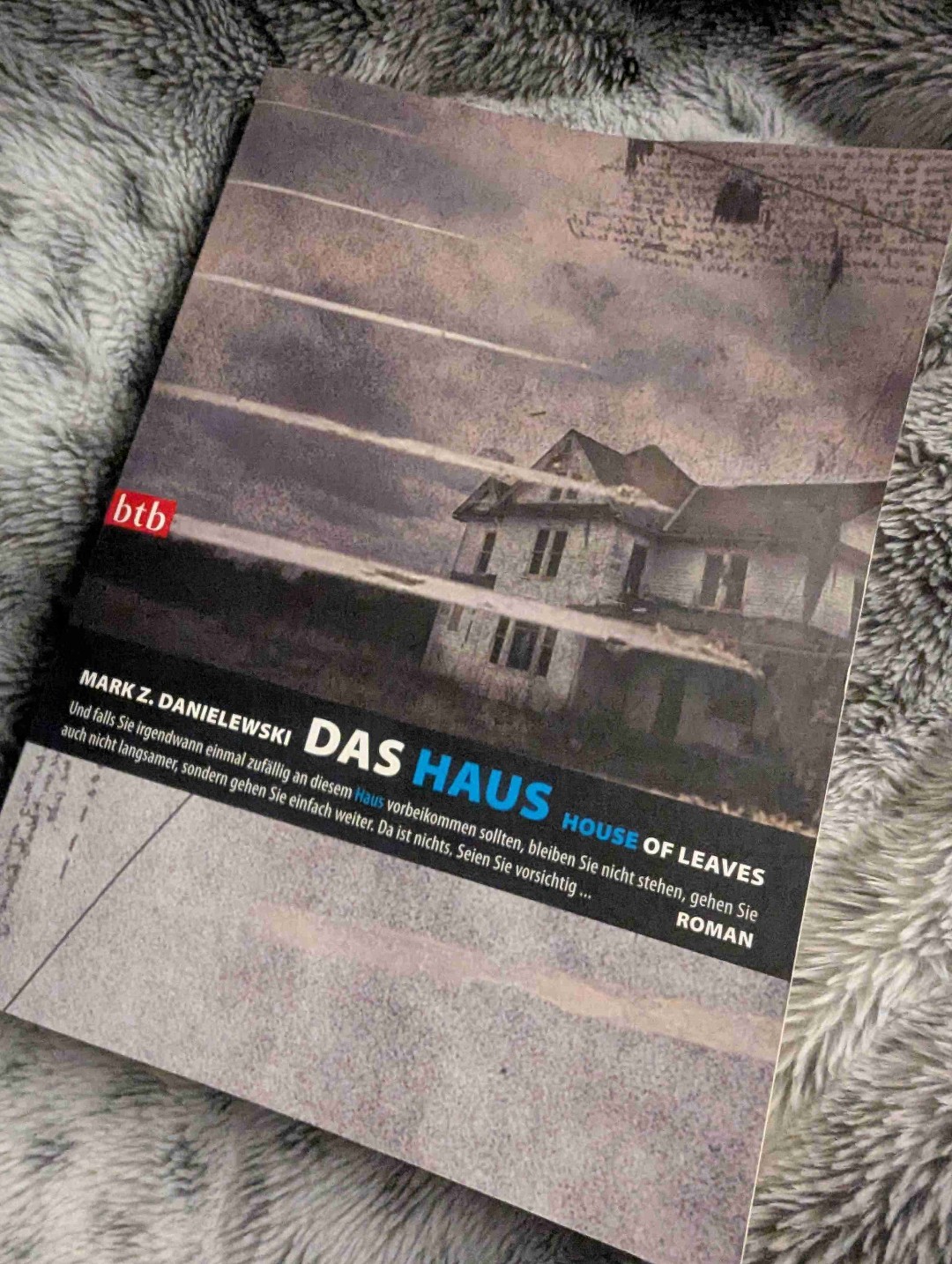Das Haus
Jetzt kaufen
Durch das Verwenden dieser Links unterstützt du READO. Wir erhalten eine Vermittlungsprovision, ohne dass dir zusätzliche Kosten entstehen.
Beschreibung
Autorenbeschreibung
Mark Z. Danielewski wurde 1966 als Sohn des polnischen Filmregisseurs Tad Danielewski geboren. Mit seinem Debütroman »House of Leaves«, an dem er über zehn Jahre gearbeitet hat, schuf er das erste Kultbuch des 21. Jahrhunderts.Seine Schwester, die Sängerin / Songwriterin Poe, hat zu dem Roman das Erfolgsalbum »Haunted« veröffentlicht.Sein zweiter Roman, »Only Revolutions«, wurde für den National Book Award nominiert.
Beiträge
4,5 ⭐
Verwirrend aber gut
Die ersten Seiten sind noch verständlich und dann wird es verwirrender, was aber seine Richtigkeit hat. Kann passieren dass man die Motivation verlieren wird und das Buch abbrechen möchte aber wer dran bleibt wird es verstehen. Es wird für Verwirrung gesorgt, Leere, Enge, was das Haus macht mit einem, während man immer weiter liest. Super Idee.

Puh..
Ich habe es abgebrochen. Wirklich schade, da ich es unbedingt lesen wollte. Es ist jedoch leider weder spannend noch einfach zu lesen. Vielleicht gebe ich ihm ein anderes Mal eine neue Chance.. aber diesmal nicht. Schade.
"Das Haus" (sowohl das Buch als auch das beschriebene Haus) zeichnen sich durch einen spannenden Aufbau aus. Die Geschichte über das Haus und den Bericht der Familie Navidson (von Zampano beschrieben und durch Fußnoten erweitert)wird zusätzlich in einer Vielzahl von Fußnoten durch Johnny Truant kommentiert bzw. begleitet. Neben der ausführlichen Ausführung des Navidson Records, in welchem die Sonderheiten des Hauses an sich sowie die familiären Verhältnisse der Navidsons thematisiert werden, erfährt man auch die verworrenen Hintergründe aus dem Leben von J. Truant. Mit ca. 800 Seiten ist dieses Buch keine leichte Lektüre für zwischendurch, auch die besondere Formatierung und die Querverweise tragen nicht zu einem entspannten Lesefluss bei. Dennoch ist es eine besondere Abwechslung, welche ich so zuvor noch nie in der Form hatte. Trotz der recht formellen Beschreibung und den ziemlich ausführlichen Abschweifungen konnte ich der Handlung gut folgen.
When rating this book I was torn between 2 and 4 stars. In the end I decided to give it 2 stars for its entire lack of readability. House of Leaves is definitely the most exhausting book I ever read. The author tells several stories that overlap each other. The central story is about the House. On its outer wall is a door that should open into the garden but instead leads into a long, dark, seemingly never-ending corridor which turns out to be a labyrinth which can change its size and cleans itself of all intruders. The story about the House is told by Zampano, an old blind man. After his death the book is found by Johnny Truant, a young drug addict with a bad childhood whose mother is in a psychiatric clinic. The author tries to make the whole story look true by giving prooves: there is a ca. 200 page long appendix. There are also masses of footnotes giving sources. Most of these sources were invented however. The lack of readability comes from the author's very special style: The story about the House is written in a very matter-of-fact, reportage-like style. Also, this central story actually is the shortest part of the whole book. The author sometimes writes page after page about different topics: architecture, physics, religion, Greek mythology, language, psychology etc. Often the structure is like this: one paragraph of the actual story, excursus to a topic touched in this paragraph, footnote giving a source and a further excursus, footnote on this footnote telling Johnny's story. So after having read 10 pages of something else you can finally go back to the real story. The author tries to make the labyrinth visible by using this method. Sometimes he also uses loops: if you follow all the footnotes eventually one footnote will put back in the text again so that you'll finally be lost in the labyrinth. Sometimes the text is also written in an experimental fashion: you have to turn the book round to be able to read it. Or there are only a few words on each page (I actually liked that because I was able to make faster progress :) All of this is very interesting. But only for about 400 pages. After this the book started to really annoy me. The book also was very different from what I expected. I have often read here on Goodreads that it is quite creepy. The central story actually is. But all the footnotes and the excursus extremely take out speed and suspense. So if you are looking for a horror novel that will really scare you, House of Leaves definitely is not the thing for you.
Beschreibung
Autorenbeschreibung
Mark Z. Danielewski wurde 1966 als Sohn des polnischen Filmregisseurs Tad Danielewski geboren. Mit seinem Debütroman »House of Leaves«, an dem er über zehn Jahre gearbeitet hat, schuf er das erste Kultbuch des 21. Jahrhunderts.Seine Schwester, die Sängerin / Songwriterin Poe, hat zu dem Roman das Erfolgsalbum »Haunted« veröffentlicht.Sein zweiter Roman, »Only Revolutions«, wurde für den National Book Award nominiert.
Beiträge
4,5 ⭐
Verwirrend aber gut
Die ersten Seiten sind noch verständlich und dann wird es verwirrender, was aber seine Richtigkeit hat. Kann passieren dass man die Motivation verlieren wird und das Buch abbrechen möchte aber wer dran bleibt wird es verstehen. Es wird für Verwirrung gesorgt, Leere, Enge, was das Haus macht mit einem, während man immer weiter liest. Super Idee.

Puh..
Ich habe es abgebrochen. Wirklich schade, da ich es unbedingt lesen wollte. Es ist jedoch leider weder spannend noch einfach zu lesen. Vielleicht gebe ich ihm ein anderes Mal eine neue Chance.. aber diesmal nicht. Schade.
"Das Haus" (sowohl das Buch als auch das beschriebene Haus) zeichnen sich durch einen spannenden Aufbau aus. Die Geschichte über das Haus und den Bericht der Familie Navidson (von Zampano beschrieben und durch Fußnoten erweitert)wird zusätzlich in einer Vielzahl von Fußnoten durch Johnny Truant kommentiert bzw. begleitet. Neben der ausführlichen Ausführung des Navidson Records, in welchem die Sonderheiten des Hauses an sich sowie die familiären Verhältnisse der Navidsons thematisiert werden, erfährt man auch die verworrenen Hintergründe aus dem Leben von J. Truant. Mit ca. 800 Seiten ist dieses Buch keine leichte Lektüre für zwischendurch, auch die besondere Formatierung und die Querverweise tragen nicht zu einem entspannten Lesefluss bei. Dennoch ist es eine besondere Abwechslung, welche ich so zuvor noch nie in der Form hatte. Trotz der recht formellen Beschreibung und den ziemlich ausführlichen Abschweifungen konnte ich der Handlung gut folgen.
When rating this book I was torn between 2 and 4 stars. In the end I decided to give it 2 stars for its entire lack of readability. House of Leaves is definitely the most exhausting book I ever read. The author tells several stories that overlap each other. The central story is about the House. On its outer wall is a door that should open into the garden but instead leads into a long, dark, seemingly never-ending corridor which turns out to be a labyrinth which can change its size and cleans itself of all intruders. The story about the House is told by Zampano, an old blind man. After his death the book is found by Johnny Truant, a young drug addict with a bad childhood whose mother is in a psychiatric clinic. The author tries to make the whole story look true by giving prooves: there is a ca. 200 page long appendix. There are also masses of footnotes giving sources. Most of these sources were invented however. The lack of readability comes from the author's very special style: The story about the House is written in a very matter-of-fact, reportage-like style. Also, this central story actually is the shortest part of the whole book. The author sometimes writes page after page about different topics: architecture, physics, religion, Greek mythology, language, psychology etc. Often the structure is like this: one paragraph of the actual story, excursus to a topic touched in this paragraph, footnote giving a source and a further excursus, footnote on this footnote telling Johnny's story. So after having read 10 pages of something else you can finally go back to the real story. The author tries to make the labyrinth visible by using this method. Sometimes he also uses loops: if you follow all the footnotes eventually one footnote will put back in the text again so that you'll finally be lost in the labyrinth. Sometimes the text is also written in an experimental fashion: you have to turn the book round to be able to read it. Or there are only a few words on each page (I actually liked that because I was able to make faster progress :) All of this is very interesting. But only for about 400 pages. After this the book started to really annoy me. The book also was very different from what I expected. I have often read here on Goodreads that it is quite creepy. The central story actually is. But all the footnotes and the excursus extremely take out speed and suspense. So if you are looking for a horror novel that will really scare you, House of Leaves definitely is not the thing for you.



